#Game Master Tips
Explore tagged Tumblr posts
Text
If you’re a new game master for Lancer this is a must-watch
youtube
8 notes
·
View notes
Text
Fudging Dice
I have a new video up on my Youtube channel, in which I discuss the practice of fudging dice as a Game Master. Arguments for and against, and what I actually do at my table.
If you play or run TTRPGs, please check out the video and give me your opinions in the comments. Do you agree with my takes? I want to know what you think either way!
youtube
#vtuber#english vtuber#ttrpg#youtube#dnd5e#dungeons and dragons#dungeon master#game master#fantasy#fudge#dice#dnd dice#advice#game master tips#dungeon master tips#dungeon world#fate#gurps#dnd#chuubo's marvelous wish granting engine#Youtube
2 notes
·
View notes
Text
Like a lot of people, I’ve spent the last several months playing the absolute masterpiece that is Larian Studios’ Baldur’s Gate 3 (BG3). It’s an amazing game, so it’s no surprise that we’ve had a long list of think pieces about the lessons it can teach us. What is a bit surprising is how many of those think pieces directly compare BG3 to 5th Edition Dungeons and Dragons (5E), along with other tabletop roleplaying games.*
At first, I didn’t think such comparisons made sense. It’s true that BG3’s mathematical values come from a significantly modified version of 5E’s rules, but they’re two completely different forms of media. One is a video game, while the other is a game played on a tabletop with real people. There are so many differences between the two experiences that I don’t even know where to start.
8 notes
·
View notes
Text
Friendly reminder for Game Masters that encounters don't always have to be "fair."
There can be a big temptation to let the dice fall where they may, and just say that the game is what it is. You want players to feel like you're not against them, or like you're not throwing them softballs, so you rely on the assurance that everyone is playing by the same rules and that good luck or bad is just up to chance...but sometimes that doesn't produce the most entertaining story.
There's no harm in "fudging" one way or the other if there's an in-universe reason for it. The guards are on a route they patrol all the time. The assassin has the favor of their dark god in this scheme. The drunkard was already having a bad day...and also he is drunk.
Maybe the debris-strewn floor of the abandoned warehouse is difficult terrain for intruders, but the gang of thieves using it as a hideout have been spending a lot of time there, and are used to walking on it as normal.
If someone has done a lot of preparation and put the work in, it's okay to let them succeed without rolling...or even better, "Roll to see if you get a critical success, but there's literally no way you can fail this."
On the other hand, sometimes it's okay to say, "You can't succeed, but if you roll high something else good will still happen."
What's most important is how you convey this to players. Let them know up-front when something isn't "by the book", even if you're vague on how. If a roll isn't needed, cop to that. If they're taking a bonus/penalty, tell them. You may make them figure out in-game why these changes are being applied, but communicate clearly with the players when they can't rely on their assumptions, and you'll be able to create more narratively satisfying moments without having to sacrifice their trust.
2 notes
·
View notes
Text
Tactics for Engaging and Dynamic 5e Battles
Combat in 5e can get boring pretty fast. Starting 30 feet away and never moving after the first round or two gets stale. However, there are some easy steps you can take when building an encounter to breathe some life into them.
Combat in 5e can get boring pretty fast. Starting 30 feet away and never moving after the first round or two gets stale. However, there are some easy steps you can take when building an encounter to breathe some life into them. The best part is you won’t have to add or remove any rules or mechanics to the game. Here is a list of tactics you can use to create more engaging and memorable combat…
View On WordPress
#1#dnd#dnd 5e#dnd combat#dnd combat encounter#dnd5e#dungeon master#dungeon master tips#dungeons & dragons#dungeons and dragons#game master#game master tips#ttrpg
4 notes
·
View notes
Text
Masterlist
Here you can find my Masterlist of all important collections, posts and lists! This will be constantly updated, so keep an eye out for new content!
✧ ˚ · . Character Creation ✧. ┊ NPC Collection World Building ✧. ┊ Thalôr World Building Question of the Day Masterlist Hastags ✧. ┊ Important Hashtags ✧ ˚ · . NOTE: This is under construction from Jan 28th until an unknown time. This post isn't finished, but needed to be posted for other reasons.
#masterlist#ttrpg#dnd#npcs#character idea#character concept#homebrew#dnd5e#art#player tips#game master tips#battlemaps#calsdice
2 notes
·
View notes
Text
I was actually thinking about this perspective yesterday, before even seeing the post. I had started a draft about what to do as a gm if your players keep going off book.
The answer is to realize while you may have created the setting, the players write the book. It's you as GM who aren't following along.
Say that you (or the author of a premade module) have created a scene where the players need to solve a sphinx's riddle to save the day. You're proud of how clever the riddle is, in fact, and maybe have even dropped some hints to help them find the correct answer.
But the party comes up with a zany plan instead to get the sphinx so drunk that they can just tiptoe past it while it's passed out.
Don't just say "unfortunately sphinxes don't drink" and make them keep trying to find the One True Solution. That way lies frustration for both players and GM. Let them try their crazy plan and most importantly, give it a real chance of working.
If the dice are kind, that's not going against the story, that's making it a better story, one that may become a legend as they retell it down the road. "Hey, remember that time we got the sphinx drunk? It was so epic!"
And don't feel disappointed if they ignored the brilliant riddle you created - file it away to use at another time!
D&D has become so much more fun since it clicked for me that I'm not the character, I'm the writer in charge of the character
30K notes
·
View notes
Text
The Rifter #11: Hidden Answers That Could Boost Your Gameplay
Could the Q&A in The Rifter #11 be the key to unlocking new adventures in your Palladium RPGs? 🔑 Find out how these insights can impact your games today! Don't stay in the dark when answers are at your fingertips. Watch now! #TheRifter #PalladiumBooks #RPG
The Rifter #11 Rifts Ultimate Edition Unlock invaluable insights with our analysis of The Rifter #11’s Q&A section and discover how it impacts your Palladium Books games today! Join us as we reveal answers to burning questions that could enhance your gameplay and storytelling. In this enlightening video, we delve into the Q&A section of The Rifter #11, uncovering clarifications and expert advice…
#game master tips#game mechanics#legion of myth#Megaverse#Palladium Books#palladium games#palladium megaverse#Palladium rifts#Palladium RPG#rifter magazine#rifts role-playing game#Rifts RPG#role-playing games#roleplaying tips#rpg content#rpg die gest#RPG gameplay#rpg magazine#rpg overview#RPG sourcebook#RPG supplement#tabletop RPG#the rifter#the rifter 11#the rifter issue 11
1 note
·
View note
Text
0 notes
Text
Experience Based Bounties
Over on My Discord Server people were talking about potential alternative uses for experience in campaigns that use milestone based levelling, which gave me an idea.
Why not use experience as general guidelines for bounties.
Take the humble goblin for example, at CR 1/4, it would provide 50xp, maybe instead of that, you put bounties out, players that kill goblins get money for doing it.
Perhaps you want the players to get paid to wipe out a cave filled with 10 goblins, 10 times 50 is 500, and then to bring that to a reasonable level, lets divide it by 100. A 5gp bounty (per person) to kill all those goblins and clear out the cave.
Lets apply the same to an adult red dragon: 18000 / 100 = a 180gp bounty (per person) just for killing the dragon (before you even get to the hoard).
These numbers can obviously be adjusted dependant on a lot of factors, but it seems a nice quick and easy way of figuring out bounties' worth, and a fun alternative use for experience points.
#dnd#d&d#dnd homebrew#dnd 5e#dungeons and dragons#dnd5e#5e homebrew#fantasy#ttrpg#homebrew#jay's rambles#dungeon master#dm times#dungeon master tips#game master#gm advice#dm advice#game master tips
1 note
·
View note
Text
Deck of Many Things - Adventure Builder - Free Version
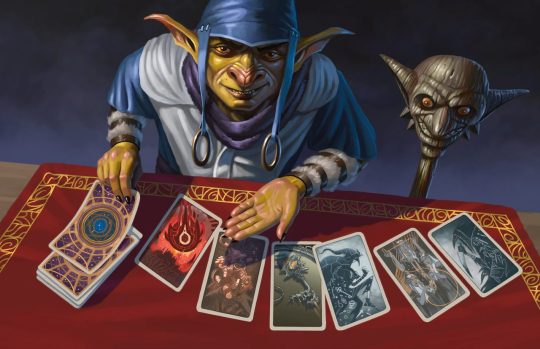
Based on D&D's official video explaining their new adventure builder in the upcoming Book of Many Things.
You preferably do need to have some cards on hand. Although, they are not necessary, and I will give some examples of d100 tables from dndspeak.com you can use instead of cards. But if you already have a Tarot deck or one of the many versions of Dixit, you can use those cards to spark your inspiration as well.
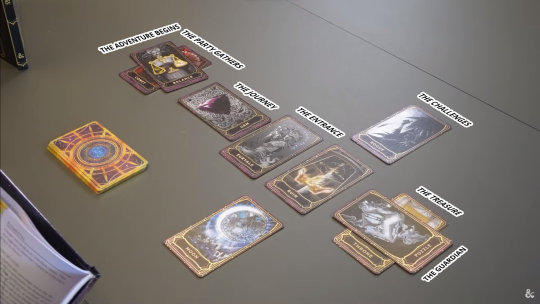
If you have a real deck of cards (Tarot or Dixit or whatever has some fancy images) lay them out like in the image above, and read the explanation below on how to interpret them for your adventure.
"The Party Gathers" Card
This card represents the situation the characters are in before the adventure starts, it might be a place that they meet, a person they’re visiting, a treasure they are drawn to for different reasons, or a dangerous creature unrelated to the adventure to follow.
Link to 100 interesting taverns and their tavernkeepers
“The Adventure Begins” Card
Place this card across the first card to represent how the adventure starts, it might be a situation that starts the action, an individual who gives the adventurers a quest, or an attack by a creature that prompts the party to follow it to its lair.
Link to 100 campaign start scenarios
“The Journey” Card
The transition from the introduction to the adventure location, probably a person, a creature, or a location the characters encounter along the way.
Link to 100 interesting forest locations
“The Entrance” Card
This card describes the entrance to the main dungeon or adventure location, it might represent a creature that guards the entrance or the physical details of the entrance itself.
Link to 100 interesting dungeon doors
“The Challenge” Cards
These cards (often 3, but can be any number of cards depending on how long you want this adventure to take) represent the various encounters the party will discover. They can take the form of a fight that breaks out, a puzzle that needs to be solved, or a situation that requires a social solution.
Link to 100 swamp encounters
“The Treasure” Card
Maybe the most important card of them all, the treasure card represents the item, boon, or creature the party finds at the end of the adventure. It is, however, guarded by what is found on the guardian card.
Link to 100 artifacts of great power
“The Guardian” Card
Also known as the “The Big Boss” card, this card represents the final threat that has to be overcome by the party. Although often a physical threat that has to be fought, the guardian can also take the form of a puzzle that is on a nerve-racking timer or someone that has to be convinced of something that goes completely against their nature.
Link to 100 eldritch horrors
I hope this helps you crafting amazing adventures for your players, even if you do not have $100,- to spend on this new product from Wizards of the Coast.
#deck of many things#dungeons & dragons#dungeons and dragons#dnd#ttrpg#dnd adventures#dungeon master tips#game master tips#ttrpg community#tabletop rpg#tabletop roleplaying#tabletop games#roleplaying games#tabletop gaming
1 note
·
View note
Text
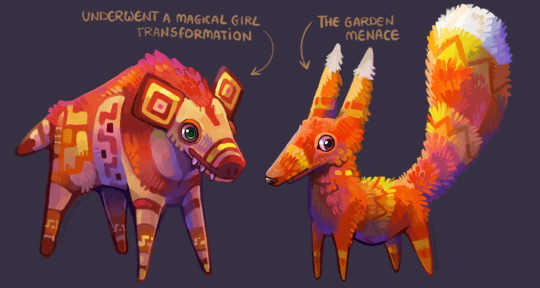
Hello I am back with more Viva Piñata doodles! Turns out if you think enough about fluffy piñatas you can force your way through art block (at least for a while)
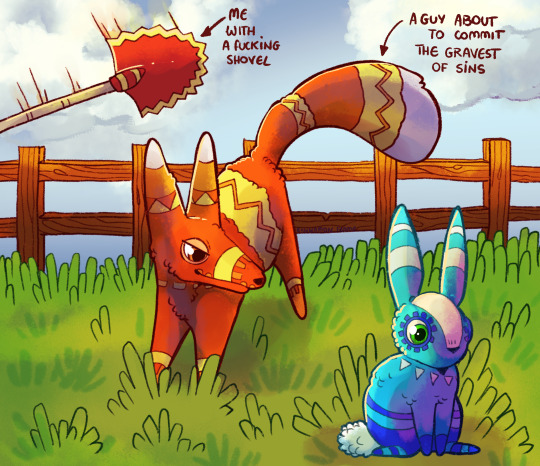
The typical Viva Piñata experience, I love you Pretztail but why are you like this I drew so many Pretztail as a "do over" of my first Viva Piñata drawing from 2018

that's when it all started
#For anyone not in the know a Pieena can be made from a Pretztail that has been gifted a bone#after that you can get it at the desert#also additional piñata lore#a Pretztail CAN AND WILL haunt your garden if you have a bunnycomb in it#they won't stop coming#they won't stop attacking them#the only way to end it is getting the master romancer achievement for pretztail and then banning them from appearing#despite this I still love those little dudes#even if they are rascals#me talking about Viva piñata designs : this is the topest tier of creature design#me actually drawing the designs : oh god what does that pattern look like from this side#this is for all the people how still somehow reblog my previous piñata drawings and comment about how they miss the games#I do too#so here I am with doodles#viva piñata#viva pinata#vp#viva pinata tip#pretztail#bunnycomb#pieena#art#cinnamon's doodles
772 notes
·
View notes
Text
youtube
My second Youtube video is now public. I was told that the previous video was to quiet. This one has had the volume boosted by 50% and seems on my end to be better. Please let me know of any audio issues.
In this video I look at the combat systems for FATE and Savage Worlds.
#english vtuber#vtuber#ttrpg#dnd5e#youtube#dungeons and dragons#FATE#Fate core#Savage Worlds#SW#fantasy#goblin#angel#angelic encounters#Game Master#dm tips#startplaying#dungeon master tips#dungeon master#Game Master tips#Youtube
0 notes
Text
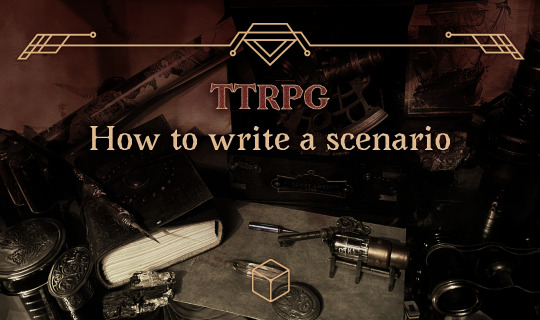
How to write a TTRPG scenario ?
As a TTRPG campaign author, I’ve struggled for years to write scenarios that were coherent, that would not be derailed by players nor would force them onto rails, and that would allow escapism while keeping them hooked. I fumbled a lot until I found a method that I found quite efficient. So I thought I’d share. Of course, what works for one might not for another, but if you’re a beginner in TTRPG scenario writing and you don’t know where to start, well, you never know, this might help you.
The first phase is of course to make a rough draft. Just pour in a text document every single idea you have, without any filter : characters, cool scenes, story twists, gameplay elements… take your time, let your mind work in the background. Then organize every item, see what works with what, what would make sense in a chronological way… and fill the holes between the elements. This would give you a first draft of your scenario, something that should fill about two pages (regardless of whether your scenario is a one-shot or a full campaign).
At this point, the most adventurous GM would have enough material to start an improvised game. This requires a very specific skillset and a lot of memory. You do you, but at this point, I’ve only just started my preparations.
If you want to keep enriching your scenario, you’ll find yourself facing two issues : first, the more structure you have, the less freedom you’ll leave your players, because you have your “canon” on what should happen in your story ; and second you might miss holes in your scenario that your player will certainly have a lot of joy (or confusion) pointing out in the middle of a game. So here’s the trick. Find who is the main antagonist in your story (whether it’s a Dark Lord or your rival in the Most Beautiful Garden Contest, if your RPG is not a sandbox you will have an antagonistic force, else your players won’t have much to do…). Now re-write your scenario, from A to Z, but FROM THE POINT OF VIEW OF THE ANTAGONIST, as if the players were not here, or were naive enough to fall into every single trap. Why ? To deal with both your issues at the same time of course ! On the one hand you can’t control your players’ decisions, but you can do it for your NPCs, so you CAN place your antagonist on rails and compensate every time they go astray without impeding on your players’ freedom. On the other hand, by writing out the details of your antagonist’s dastardly plan, you increase your chances to see a blatant error or omission and correct it.
Once this is done, you’ll want to identify the key elements of this plan, those that your villain absolutely need, else their objectives crumble. Those will be your “fixed points”. Your mission as a GM is to ensure that these fixed points happen no matter what your players do, in order to guide them along your main scenario. The remainder of the plan will be your “mobile points”, which your players will have way more control over. This will create a structure for your story, and you can complete the scenario with the mobile points, leaving as much freedom to your PCs as you want in them.
There’s one last task before you finish your story. Now that you have every step of your scenario, maybe even a division into chapters using the fixed points, you can do three lists :
the places your players will visit
the NPCs they will meet
the lore elements they’ll have to learn
Using these three lists, you’ll be able to re-write one last time your whole scenario. Now you’ll have a rich story, with a way more formidable antagonistic force, and more freedom for your players.
You can totally start your campaign using these documents, using the three lists as reminders
Of course, if you’re like me and you like to Plan Out Everything in advance, you’re only at the beginning of your work : every place, every NPC, every fixed and mobile point will need their own detailed page ; and some more elements will need detailing. But we’ll talk more about it in a future article, so stay tuned !
#jdr#jeu de rôles#role playing game#role playing games#rpg#tabletop roleplaying#tabletop rpgs#ttrpgs#ttrpg#indie ttrpg#ttrpg community#writing#writing tips#dungeon master
144 notes
·
View notes
Text
Writing Your D&D Character Backstory
Creating your D&D character can seem a bit overwhelming, especially if you're new to the game. You have to remember the numbers and abilities that tie into other numbers and your characters species- On top of that, you have to write a story for them? I'll admit, it gets to be a little much.
You can choose to not have a fully fleshed out backstory for your character, and build them with the world you're playing in. (Utilizing amnesia, forgetfulness spells, or curses are always good) Open ended backstories can become a great way for you and the DM to "Yes and-" your way into new plot hooks.
However daunting it might seem, writing your D&D character backstory can be one of the most fun things about the game.
No matter how you play your game, backstories can come in useful, for both role playing your character, and for the DM to write more interesting plot hooks surrounding specific character arcs. It can provide you with contacts in certain cities, allied factions that can help you out in a pinch, or recurring rivals that seek to undo your best-laid plans.
Without further ado, let's get into these tips and tricks I hope will help you through the process of writing your backstory.
1. Who are you?
The most important thing your backstory needs to cover is who exactly your character is. This is essentially what the whole backstory should be about; Building a fleshy cover for that skeleton you made on your character sheet.
A few major essential things your backstory should cover are:
Your name, age, and a physical description of your character.
Where you came from
Does this character have a family? Do they know who they are?
At least one character belief and/or goal.
Simple, right? Your backstory doesn't have to be a 60 page epic about how you went from your hometown to the town over and found a sword along the way.
Getting these things into a backstory is generally enough to begin role playing at a very basic level. It also provides you with a really good basis for adding more to the backstory at a later date, with your DM's approval.
2. Add a bit of Drama
Once you have a good understanding of who your character is, writing drama into your backstory will add depth to your character.
Does your character have love interest that was killed, breaking their heart? Or, maybe your barbarian resents her tribe for choosing a new leader above her?
Whatever the drama is, it's important to have some be open-ended. Unresolved trauma/dramatic events can be an early present for any DM, and gleefully they may unfold your characters story arc in front of you. (Some DM's are not as excited as I am about backstory integration, so make sure to talk to your DM before adding them in.)
Having a few dramatic events in your backstory can help tie your character to the world. Maybe they can't go back to a certain tavern since they got caught cheating at dice, or maybe they need to get to the church several months ride away as quickly as possible to stop their true love from getting married.
Your characters drama is what makes them more 'real'. Having talks with their new-found allies about their lives around campfires, or while in a lull traveling through hyperspace, these stories form unbreakable bonds between characters and will strengthen your own love of your character.
3. Play to your weaknesses
You are flawed, and so is your character. Every character should have at least one major flaw, and a handful of minor ones. When creating your character (unless you are particularly lucky) you should have an ability score in the minuses: Utilize It!
A character with a minus in charisma could be a lovely fool that always manages to say the wrong thing, or a grumpy teenager unable to express themselves properly.
Starting at level 1, your character is going to be inherently weak, whether that be due to lack of experience (EXP) or by some tragic mishap of having all of your powers and abilities stripped away. Writing for the situation is vital, you probably won't have achieved world peace, killed an evil demon, and reinvented the wheel before the campaign starts.
Whatever your character flaws are, there are some simple guidelines that I tend to follow when writing weakness into my character:
Don't go overboard.
Use your character sheet and stats to help.
Don't be a god when you're level 1.
Tie your flaws to your dramatic/traumatic section.
Remember, your flaws are what makes your character interesting, but don't have so many it intrudes on other players fun.
4. Work with your DM
It helps to ask your DM for help when it comes to writing your backstory, since they know how the world works.
With their input you can develop secrets to keep from the other players, write in rivals to challenge you at every turn, write additional characters that can help you out when you need a place to stay in the middle of nowhere.
Any DM worth their salt will help a player develop a character that they enjoy playing. After all, it is a game that we're playing for fun. Don't be afraid to do something weird and off the wall, characters that stray outside of the conventional character stereotypes are often really fun and interesting. That being said, character conventions are nothing to be scared of, adding a twist to the expected can be just as fun.
5. Do multiple drafts
Doing multiple drafts of a backstory is both a luxury and a necessity.
I know I've made many MANY drafts for my PC's, it's fun to scribble down little ideas throughout the day or add in cool details you find in books or on the internet
Sometimes, you simply do not have the time to do multiple drafts, asking your DM if you can change and add certain things once the story starts should not be a problem. If you are unable to do multiple drafts prior to starting, an evolving backstory in this way is a great way to compensate, so long as your DM is game and you don't just make up game breaking character changes midway through a vital encounter.
If you do have the time to do multiple drafts however, this is a vital thing to do. Drafting a characters backstory allows you to take a break, come back and adapt things, change the way some things are written, rethink and rework some of those weirder plot lines.
Making sure that you wrote things in a clear cut, simplistic way so that ambiguity doesn't end up leading to a big misunderstanding in the plot line is very important. More-so, the more drafts you do, the better you end up knowing your character, which, helps those who are new or not confident at role playing.
6. Write in the first person
This one should be obvious, it really helps to get into character.
Writing from your characters perspective allows you to make out-of-character notes within the backstory that clarify situations for anyone reading. Plus your character may have a skewed view of what happened in certain events.
Checklist
Here is a small checklist of things that you might want to consider putting into your backstory, some that I've written about above and some I will leave until a later post. Feel free to pick and choose what you put in and what you leave out.
Description of your character
Information on their hometown and family
The story of how they got their powers/abilities
A good friend that you've lost contact with
A rival
A major flaw
A few minor flaws
A secret
A mystery
An unresolved bit of trauma
A love interest
An object they need to get their hands on
Ties to a particular town / city / faction
A vice
A morally questionable belief or ideal
Odd quirks
I hope this post helped you to write your character backstory in some way, I will be doing a part 2 and further posts in my tricks and tips series, for players and DMs alike.
Thanks for reading my first ever post!
#dungeons and dragons#dnd#dnd character#dnd oc#dnd5e#character building#character backstory#character blog#writing#creative writing#writeblr#writers on tumblr#ttrpg#ttrpg community#indie ttrpg#ttrpg art#pathfinder#critical role#dnd blog#fun games#dungeon master#notetaker#homebrew#dnd campaign#first post#character flaws#flaws and all#love your flaws#flaws#writing tips
27 notes
·
View notes
Text
underrated way to terrify your players: ask one of them their character’s dick size and say it’s relevant to an upcoming dungeon
#it *is* relevant#technically.#because if this happens i know damn well my players r gonna ask#and i may as well already have an answer#anyway i’m reskinning the amber temple bc i think it should be more cosmic horror-y and now the monster that pantses you is here#the monster that pantses you#anyway. yeah stay tuned for that it’s literally one room out of 45 so they might not even get there#dnd#d&d#curse of strahd#dungeons & dragons#dungeons and dragons#dungeon master#dm#gm#game master#dm things#dm tips#d&d dm#d&d party#d&d 5e
10 notes
·
View notes